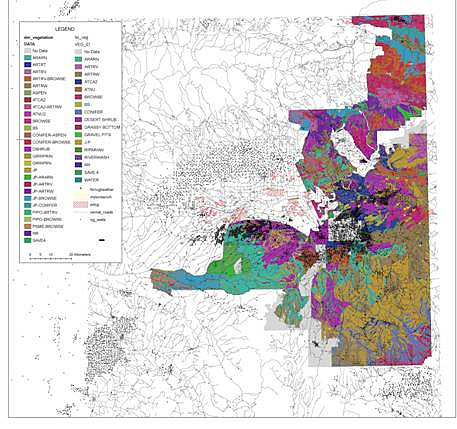Lands owned and operated by BLM are increasingly being evaluated for and used as natural gas and oil exploration and production (E&P) sites in order to reduce the country’s reliance on foreign energy sources. Under the National Environmental Policy Act (NEPA), proposed E&P sites on Federal lands must be evaluated for the cumulative impact on the environment of activities such as the construction of new roads, placement of wellheads and tank batteries, and installation of pipelines. Of particular concern is the effect of fragmentation caused by such activities on the habitats of vertebrate species of special status.
Oil and gas wells affect habitat suitability for mammals and birds; the simplest mechanism is by removing patches of vegetation. Noise and traffic associated with producing wells are likely to extend impacts on habitat suitability to larger areas. The magnitude of the impact on a population is expected to be related to the pattern of development and potential for habitat fragmentation, as well as to the number of wells. Population responses to oil and gas development are expected to vary depending on life history and trophic level.
Results
This project will result in two submitted journal articles or reports, one led by LLNL, one led by ORNL. These manuscripts will summarize population modeling results for the black-tailed prairie dog (LLNL) and greater sage grouse (ORNL) in northeastern Utah, as potentially impacted by the pattern of current or planned oil and gas development. Research outcomes are in progress.
Benefits
The results of these parallel studies will provide industry, BLM, other regulatory agencies, and DOE with an understanding of the levels and patterns of oil and gas development that might impact prairie dog and/or sage grouse populations, as well as preliminary findings concerning the optimization of well placement to benefit these populations. Models will be available for additional evaluations.
Summary
ORNL and LLNL have made substantial progress on several project milestones: 1) reviewing relevant exploration and production activities on BLM lands managed by the Vernal field office; 2) finalizing site and species selection; 3) acquiring species and site data; 4) developing a GIS (geographic information system) database of selected landscape; 5) generalizing the population models previously developed for American badger and prairie vole and testing them for greater sage grouse and white-tailed prairie dog, respectively; 6) conducting initial simulations; 7) beginning to simulate future development alternatives; and 8) beginning to prepare final manuscripts.
The greater sage grouse was selected as the focal species of the ORNL model. The boundaries of the study site were selected based on breeding areas of sage grouse and ongoing oil and gas development: the Deadman Bench breeding complex in Uintah County (which includes East Bench) and the Book Cliffs breeding complex (which crosses Uintah and Grand Counties. ORNL finalized the initial number of grouse for the simulation area, i.e., 404, based on information and expertise of the Utah Division of Wildlife Resources. A habitat suitability map for sage grouse was acquired from the Southwest Regional Gap Analysis program. USU provided maps of existing wells. Based on planned development in this region, ORNL plans to place 1,000 additional wells in this study area in their simulations.
Species data and model parameters were developed from several sources. These considerations have included the importance of density-dependent survival, environmental drivers of sage grouse success, seasonal habitat issues, movement distances and barriers to movement, hunting pressure, population trend, minimum flock (covey) size, flock merging behavior, and empirical studies of sage grouse responses to oil and gas development.
Many model algorithms have been implemented, including movement, territory acquisition, immigration, breeding, nesting, and seasonal changes in flocking behavior. Flocking was a particularly challenging behavior to simulate. The sage grouse population model has been ported to a supercomputer cluster in preparation for simulating future development alternatives.
The white-tailed prairie dog was selected as the focal species for the LLNL model. LLNL will use sites within the northeastern area of Utah, including the Book Cliffs region, Coyote Basin, Diamond Mountain, Glen Bench, and Myton Bench during the simulation runs. All areas have good prairie dog representation and vary in degree of oil and gas development. LLNL will model one to several of these areas, which span the range of prairie dog density and oil and gas development.
The LLNL individual-based rodent model explicitly represents foraging and predation. The model focuses on interactions (e.g., vegetation growth and reduction due to grazing, herbivory, and bioenergetics) that may cause indirect, population-level effects associated with habitat loss. The trophic approach captures the interdependence between population density and environmental characteristics that could be altered by climate or human activities (including E&P related activities), such as vegetation density, unsuitable vegetation, or lack of vegetation. Species data and model parameters were developed from several sources, including a literature review conducted by USU and review of reports prepared in support of listing under the Endangered Species Act.
LLNL created of a total of nine maps from the GIS files provided by USU and BLM of northeastern Utah (road, oil and gas wells, vegetation, and prairie dog colonies). For the simulations, ASCII files containing extracted landscape data (vegetation, roads, oil and gas wells), as well as initial species density from the GIS information, will be used.
The vole model graphical user interface has been generalized to allow selection of the rodent species to be modeled. Current species options include the prairie vole and the white-tailed prairie dog. Parameter tables have been modified to include parameters specific to the white-tailed prairie dog. Growth of various graminoids has been successfully simulated using the Century vegetation model, used to develop the vegetation growth curves as input to the rodent model.




